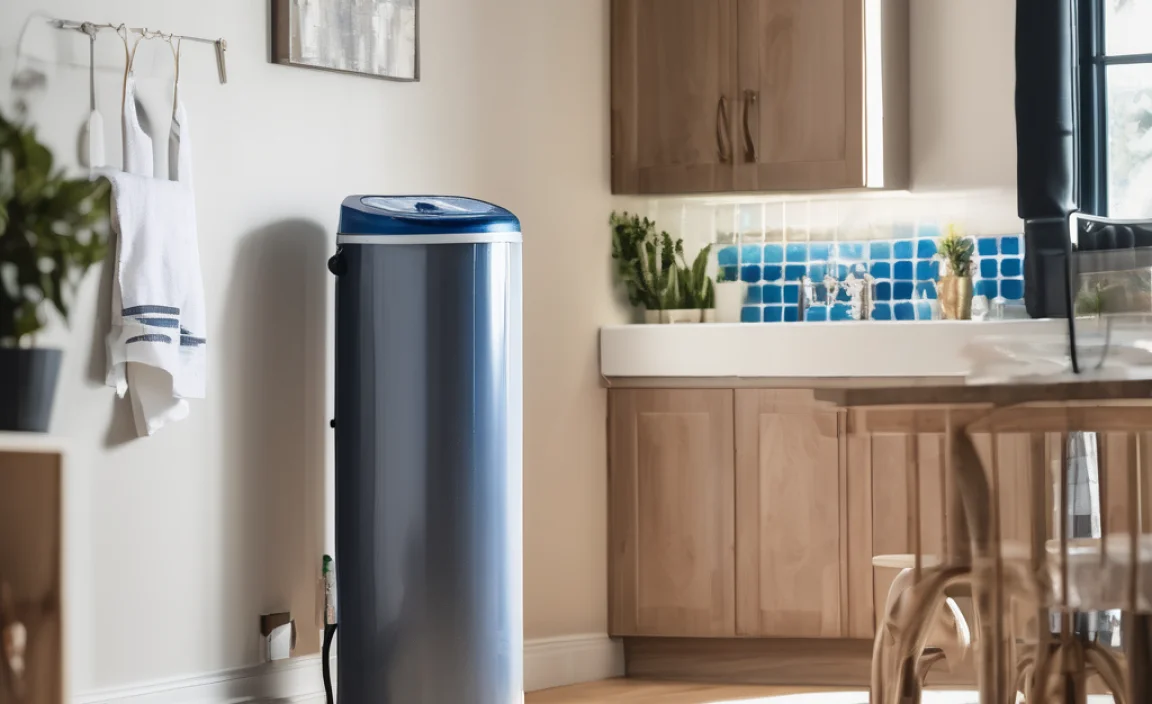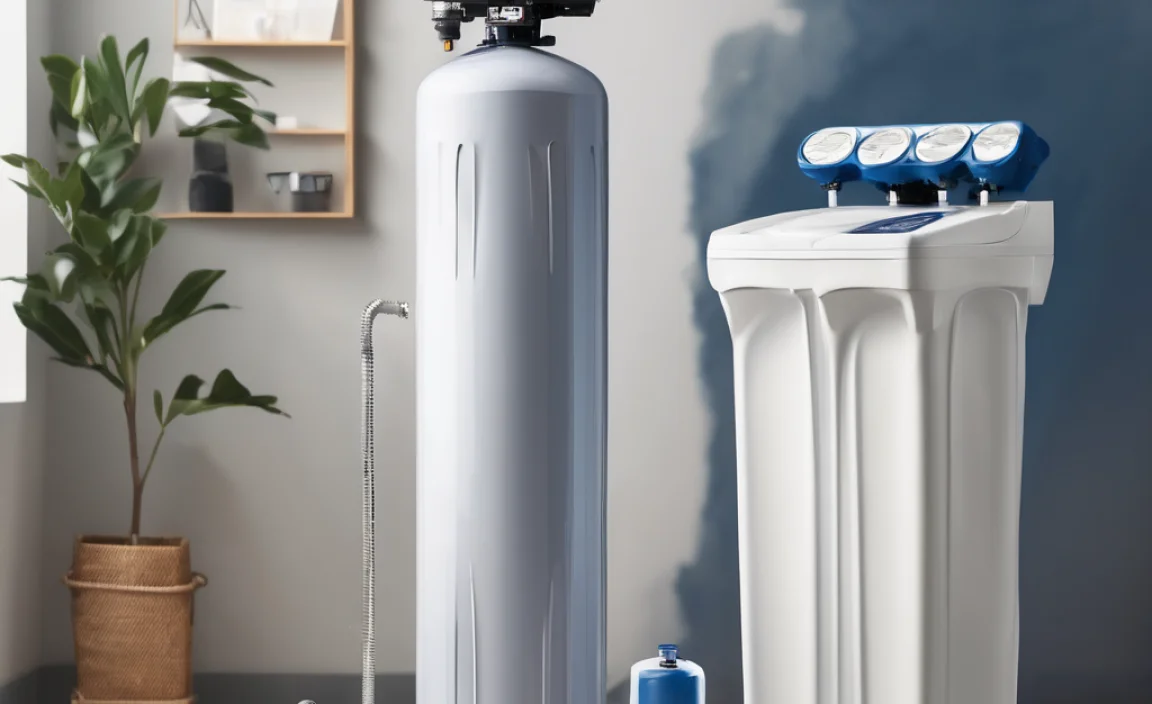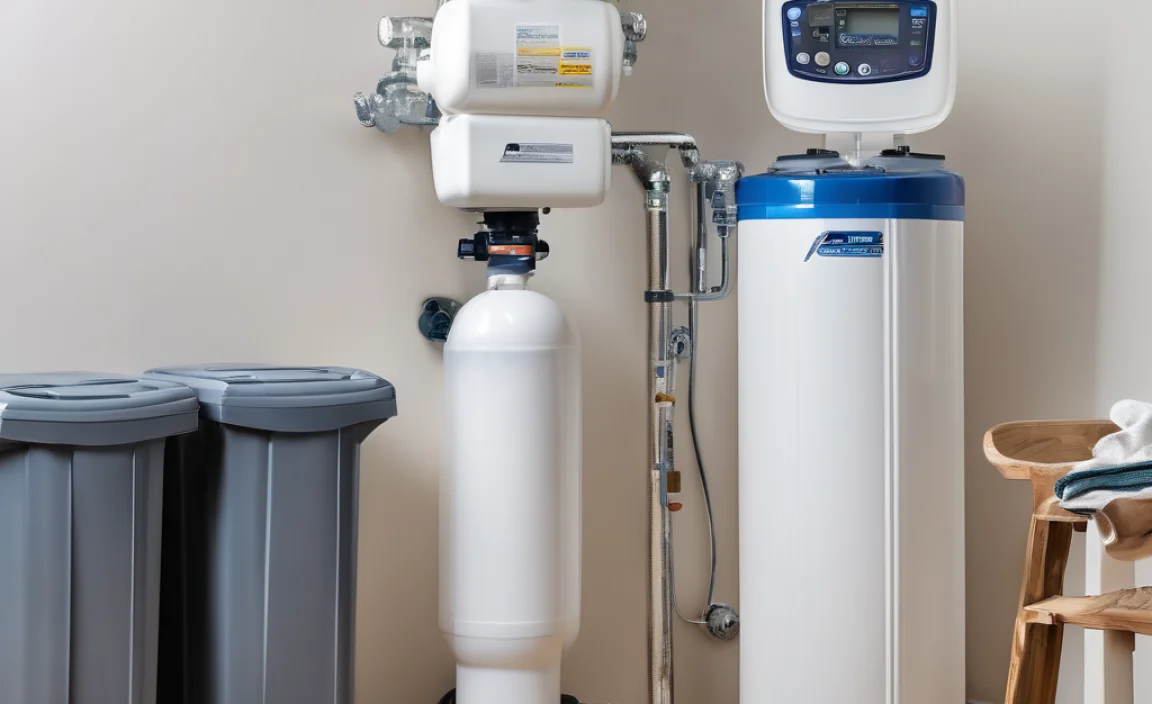To keep your water softener working like a charm, plan to service it every year. This includes checking the salt levels monthly and cleaning the brine tank every few months. A yearly deep clean and inspection will catch any small issues before they become big, expensive problems. Regular maintenance ensures you always have soft water!
Is your water feeling a bit hard lately? Don’t worry; you’re not alone! Many homeowners face the same issue. Hard water can lead to scale buildup, dry skin, and even affect how well your appliances work. The good news is that a water softener can solve these problems. But, like any helpful tool, it needs a little TLC to keep running smoothly.
Knowing how often to service your water softener is key to keeping it efficient and extending its lifespan. In this guide, we’ll walk you through everything you need to know, step by step. We’ll cover regular maintenance, cleaning tips, and when it’s time to call a pro. Let’s get started and make sure you always have soft water!
Why Water Softener Maintenance Matters

Think of your water softener like a car. You wouldn’t drive for years without an oil change, right? The same goes for your water softener. Regular maintenance keeps it running efficiently and prevents costly repairs. Here’s why it’s so important:
- Extends Lifespan: Regular servicing prevents wear and tear, helping your softener last longer.
- Maintains Efficiency: A clean, well-maintained system softens water better and uses less salt.
- Prevents Breakdowns: Catching small issues early can prevent major malfunctions.
- Saves Money: Efficient operation reduces salt and water waste, saving you money on utility bills.
- Ensures Water Quality: Proper maintenance ensures your water is free from contaminants and safe to use.
How Often Should You Service Your Water Softener?

So, how often should you actually roll up your sleeves and get to work? Here’s a simple breakdown:
- Monthly: Check salt levels and add salt as needed.
- Every 3-4 Months: Clean the brine tank to prevent salt buildup.
- Annually: Perform a thorough inspection and cleaning of all components.
Let’s dive into each of these tasks in more detail.
Monthly Maintenance: Checking Salt Levels
Your water softener uses salt to remove minerals like calcium and magnesium from your water. Keeping the salt tank filled is crucial for it to work properly.
Steps to Check Salt Levels:
- Locate the Brine Tank: This is usually a large plastic tank next to your water softener unit.
- Open the Lid: Remove the lid to check the salt level inside.
- Check the Salt Level: The tank should be at least one-third full. Ideally, keep it about half to two-thirds full.
- Add Salt if Needed: Pour in more salt if the level is low. Don’t fill it to the very top; leave a few inches of space.
- Choose the Right Salt: Use high-quality water softener salt, such as rock salt, solar salt, or evaporated salt pellets. Avoid using table salt or ice-melting salt, as these can damage your system.
Every 3-4 Months: Cleaning the Brine Tank
Over time, salt can create a buildup or “salt bridge” in the brine tank. This can prevent the salt from dissolving properly and reduce the softener’s efficiency.
Steps to Clean the Brine Tank:
- Turn off the Water Softener: Unplug the unit or turn off the power switch.
- Bypass the Water Softener: This stops water from entering the unit during cleaning.
- Remove the Salt: Scoop out any remaining salt from the tank. If there’s a salt bridge, break it up with a broom handle or similar tool.
- Remove the Water: Use a wet/dry vacuum or a bucket to remove any water from the bottom of the tank.
- Clean the Tank: Scrub the inside of the tank with warm, soapy water. Rinse thoroughly to remove any soap residue.
- Inspect the Brine Well: This is the plastic tube inside the tank. Remove it and clean it separately.
- Reassemble and Restart: Put everything back together, add fresh salt, and turn the water softener back on.
Annually: Thorough Inspection and Cleaning
Once a year, it’s a good idea to give your water softener a more comprehensive checkup. This includes inspecting all the components and cleaning the resin tank.
Steps for Annual Inspection and Cleaning:
- Check the Resin Tank: The resin beads inside this tank are what actually soften the water. Over time, they can become coated with iron and other minerals, reducing their effectiveness.
- Sanitize the System: Pour a cup of household bleach into the brine well (the tube where the salt sits). This will help kill any bacteria in the system.
- Run a Regeneration Cycle: Manually start a regeneration cycle to flush out the bleach and clean the resin beads.
- Inspect Valves and Connections: Check all valves, fittings, and connections for leaks or damage. Replace any worn parts.
- Check the Drain Line: Make sure the drain line is clear and free from obstructions.
- Test the Water: After cleaning, test your water to make sure it’s being softened properly. You can use a simple water hardness test kit, which you can find at most hardware stores.
Troubleshooting Common Water Softener Issues

Even with regular maintenance, you might encounter some common issues. Here’s how to troubleshoot them:
- Hard Water: If your water isn’t getting soft, check the salt level and make sure the softener is regenerating properly.
- Salty Water: This could be caused by a malfunctioning valve or a problem with the regeneration cycle.
- No Water: Check the bypass valve to ensure it’s not preventing water from entering the softener.
- Excessive Salt Use: This can be due to a leak, a faulty valve, or incorrect settings.
- Unusual Noises: Grinding or clicking sounds could indicate a problem with the motor or gears.
When to Call a Professional

While many maintenance tasks are DIY-friendly, some issues require a professional touch. Call a plumber or water softener specialist if you experience any of the following:
- Complex Repairs: If you’re not comfortable disassembling and repairing the unit yourself.
- Persistent Problems: If you’ve tried troubleshooting but the issue continues.
- Warranty Issues: Some repairs may need to be done by an authorized technician to maintain your warranty.
Choosing the Right Water Softener Salt

The type of salt you use can affect your water softener’s performance. Here’s a quick guide:
- Rock Salt: This is the cheapest option, but it contains impurities that can build up in the tank.
- Solar Salt: Made from evaporated seawater, it’s purer than rock salt and dissolves more easily.
- Evaporated Salt Pellets: This is the purest form of salt, minimizing buildup and maximizing efficiency.
- Potassium Chloride: A salt-free alternative for those who want to avoid sodium in their water.
Here’s a comparison table to help you decide:
| Salt Type | Purity | Cost | Pros | Cons |
|---|---|---|---|---|
| Rock Salt | Low | Low | Inexpensive | Contains impurities, can cause buildup |
| Solar Salt | Medium | Medium | Purer than rock salt, dissolves easily | May still contain some impurities |
| Evaporated Salt Pellets | High | High | Very pure, minimizes buildup | More expensive |
| Potassium Chloride | High | High | Salt-free alternative | More expensive, may not be as effective |
Tips for Extending the Life of Your Water Softener
Want to get the most out of your water softener? Here are some extra tips:
- Use Salt Efficiently: Avoid overfilling the tank, as this can lead to salt bridges and clumping.
- Monitor Water Usage: High water usage can strain the system. Fix any leaks promptly.
- Protect from Extreme Temperatures: Keep the softener in a location that won’t freeze or overheat.
- Regularly Inspect: Make it a habit to check the system regularly for any signs of trouble.
DIY vs. Professional Servicing: What’s Right for You?
Deciding whether to handle water softener maintenance yourself or hire a professional depends on your comfort level and the complexity of the task. Here’s a breakdown to help you choose:
| Task | DIY | Professional |
|---|---|---|
| Checking Salt Levels | Easy | Not Necessary |
| Cleaning the Brine Tank | Moderate | Optional |
| Annual Inspection | Moderate | Recommended |
| Complex Repairs | Difficult | Necessary |
| System Sanitization | Easy | Optional |
Cost of Water Softener Maintenance
Maintaining your water softener can involve some costs, but it’s generally affordable compared to the price of repairs or premature replacement. Here’s a breakdown of potential expenses:
- Salt: The cost of salt varies depending on the type and quantity you purchase. On average, a bag of water softener salt costs between $5 and $20.
- Cleaning Supplies: Basic cleaning supplies like soap, water, and a scrub brush are usually inexpensive.
- Replacement Parts: Small parts like O-rings, valves, or connectors may need to be replaced periodically. These typically cost between $5 and $50.
- Professional Servicing: If you hire a professional for annual maintenance or repairs, expect to pay between $100 and $300 per visit.
- Water Testing Kits: A basic water hardness testing kit costs around $10 to $30.
Tools You’ll Need for Water Softener Maintenance
Having the right tools on hand can make water softener maintenance much easier. Here’s a list of essential items:
- Bucket: For removing water from the brine tank.
- Wet/Dry Vacuum: An alternative to a bucket for removing water and debris.
- Scrub Brush: For cleaning the brine tank and other components.
- Screwdrivers: For removing and replacing parts.
- Wrenches: For tightening and loosening fittings.
- Water Hardness Test Kit: For testing the effectiveness of your water softener.
- Gloves: To protect your hands during cleaning.
Understanding Water Hardness
Water hardness is measured in grains per gallon (GPG) or parts per million (PPM). Here’s a general guideline:
- 0-3 GPG (0-51 PPM): Soft
- 3-7 GPG (51-120 PPM): Moderately Hard
- 7-11 GPG (120-180 PPM): Hard
- 11+ GPG (180+ PPM): Very Hard
Knowing your water hardness level can help you adjust your water softener settings for optimal performance. You can usually find this information on your local water utility’s website or by testing your water. You can buy a test kit online or at most hardware stores.
Water Quality and Safety
Maintaining your water softener isn’t just about convenience; it’s also about ensuring the safety and quality of your water. Poorly maintained systems can harbor bacteria or fail to remove harmful minerals. Regular maintenance helps ensure that your water is safe for drinking, cooking, and bathing.
FAQ About Water Softener Maintenance
Q: How do I know if my water softener needs servicing?
A: Signs include hard water, excessive salt use, salty-tasting water, or unusual noises from the unit.
Q: Can I use any type of salt in my water softener?
A: No, use only water softener salt, such as rock salt, solar salt, or evaporated salt pellets. Avoid table salt or ice-melting salt.
Q: How often should I add salt to my water softener?
A: Check the salt level monthly and add salt when the tank is about one-third full.
Q: What is a salt bridge, and how do I fix it?
A: A salt bridge is a hard crust that forms in the brine tank, preventing salt from dissolving. Break it up with a broom handle or similar tool.
Q: Can I clean my water softener with vinegar?
A: Yes, you can use vinegar to clean the brine tank. Mix it with warm water for best results.
Q: How long should a water softener last?
A: With proper maintenance, a water softener can last 10-15 years.
Q: Is it safe to drink softened water?
A: Yes, softened water is generally safe to drink, but some people may not like the taste due to the added sodium.
Conclusion
Taking care of your water softener might seem like a chore, but it’s really an investment in your home and your health. By following these simple steps, you can keep your system running smoothly, prevent costly repairs, and enjoy soft, clean water for years to come. Remember, regular maintenance is the key to a long-lasting and efficient water softener. So, roll up your sleeves, grab your tools, and give your water softener the TLC it deserves. You’ll be amazed at the difference it makes!

